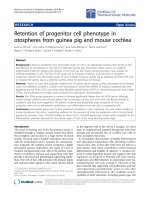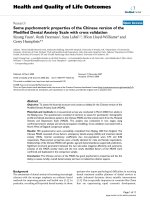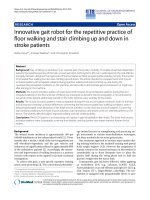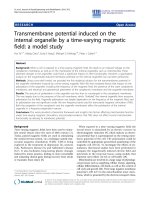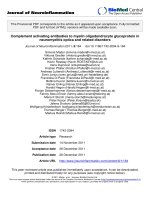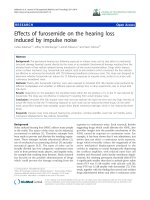Báo cáo hóa học: " Some new identities on the twisted carlitz’s q-bernoulli numbers and q-bernstein polynomials" ppt
Bạn đang xem bản rút gọn của tài liệu. Xem và tải ngay bản đầy đủ của tài liệu tại đây (229.16 KB, 6 trang )
RESEARC H Open Access
Some new identities on the twisted carlitz’s
q-bernoulli numbers and q-bernstein polynomials
Lee-Chae Jang
1
, Taekyun Kim
2*
, Young-Hee Kim
2
and Byungje Lee
3
* Correspondence:
2
Division of General Education-
Mathematics, Kwangwoon
University, Seoul 139-701, Republic
of Korea
Full list of author information is
available at the end of the article
Abstract
In this paper, we consider the twisted Carlitz’s q-Bernoulli numbers using p-adic q-
integral on ℤ
p
. From the construction of the twisted Carlitz’s q -Bernoulli numbers, we
investigate some properties for the twisted Carlitz’s q-Bern oulli numbers. Finally, we
give some relations between the twisted Carlitz’s q-Bernoulli numbers and q-
Bernstein polynomials.
Keywords: q-Bernoulli numbers, p-adic q -integral, twisted
1. Introduction and preliminaries
Let p be a fixed prime number. Throughout this paper, ℤ
p
,
Q
p
and
C
p
will d enote the
ring of p-adic integers, the field of p -adic rational numbers and the completion of alge-
braic closure of
Q
p
, respectively. Let N be the set of natural numbers, and let ℤ
+
= N ∪
{0}. Let ν
p
be the normalized expon ential valuation of
C
p
with
|p|
p
= p
−ν
p
(
p
)
=
1
p
. In this
paper, we assume that
q ∈
C
p
with |1 - q|
p
<1.Theq-number is defined by
[x]
q
=
1 − q
x
1 −
q
. Note that lim
q ® 1
[x]
q
= x.
We say that f is a uniformly differentiable function at a point a Î ℤ
p
, and denote
this property by f Î UD(ℤ
p
),ifthedifferencequotient
F
f
(x, y)=
f (x)−f (y )
x−
y
has a limit
f’(a)as(x, y) ® (a, a). For f Î UD(ℤ
p
), the p-adic q-integral on ℤ
p
, which is called the
q-Volkenborn integral, is defined by Kim as follows:
I
q
(f )=
Z
p
f (x)dμ
q
(x) = lim
N→∞
1
[p
N
]
q
p
N
−1
x=0
f (x)q
x
,(see[1])
.
(1)
In [2], Carlitz defined q-Bernoulli numbers, whic h are called the Carlitz’s q-Bernoulli
numbers, by
β
0,q
=1, and q(qβ +1)
n
− β
n,q
=
1if n =1,
0if n > 1,
(2)
with the usual convention about replacing b
n
by b
n, q
.
In [2,3], Carlitz also considered the expansion of q-Bernoulli numbers as follows:
β
(h)
0,q
=
h
[h]
q
,andq
h
(qβ
(h)
+1)
n
− β
(h)
n,q
=
1if n =1,
0if n > 1
,
(3)
Jang et al. Journal of Inequalities and Applications 2011, 2011:52
/>© 2011 Kim et al; licensee Springer. This is an Open Access article dist ributed under the terms o f the Creative Commons Attr ibution
License ( icenses/by/2.0), which permits unrest ricted use, distribution , and reproduction in any medium,
provided the original work is properly cited.
with the usual convention about replacing (b
(h)
)
n
by
β
(h)
n,
q
.
Let
C
p
n
= {ξ|ξ
p
n
=1
}
be the cyclic group of order p
n
, and let
T
p
= lim
n→∞
C
p
n
= C
p
∞
=
n
≥
0
C
p
n
(see [1-16]). Note that T
p
is a locally constant space.
For ξ Î T
p
, the twisted q-Bernoulli numbers are defined by
t
ξe
t
− 1
= e
B
ξ
t
=
∞
n
=
0
B
n,ξ
t
n
n!
,
(4)
(see [1-19]). From (4), we note that
B
0,q
=0, and ξ(B
ξ
+1)
n
− B
n,ξ
=
1if n =1,
0if n > 1
,
(5)
with the usual convention about replaci ng
B
n
ξ
by B
n,ξ
(see [17-19]). Recently, several
authors have studied the twisted Bernoulli numbers and q-Bernoulli numbers in the
area of number theory(see [17-19]).
In the viewpoint of (5), it seems to be interesting to investigate the twisted properties
of (3). Using p-adic q-integral equation on ℤ
p
, we investigate the properties of the
twisted q-Bernoulli numbers and polynomials related to q-Bernstein polynomials. From
these properties, we derive some n ew identities for the twisted q-Bernoulli numbers
and polynomials. Final purpose of this paper is to give some relations between the
twisted Carlitz’s q-Bernoulli numbers and q-Bernstein polynomials.
2. On the twisted Carlitz ‘s q-Bernoulli numbers
In this section, we assume that n Î ℤ
+
, ξ Î T
p
and
q ∈
C
p
with |1 - q|
p
<1.
Let us consider the nth twisted Carlitz ’s q-Bernoulli polynomials using p-adic q-
integral on ℤ
p
as follows:
β
n,ξ,q
(x)=
Z
p
[y + x]
n
q
ξ
y
dμ
q
(y)
=
1
(1 − q)
n
n
l=0
n
l
(−1)
l
q
lx
Z
p
ξ
y
q
ly
dμ
q
(y)
=
1
(1 − q)
n−1
n
l
=
0
n
l
l +1
1 − ξ q
l+1
(−1)
l
q
lx
.
(6)
In the special case, x =0,b
n,ξ,q
(0) = b
n,ξ,q
are called t he nth twisted Carlitz’ s
q-Bernoulli numbers.
From (6), we note that
β
n,ξ,q
(x)=
1
(1 − q)
n−1
n−1
l=0
n
l
(−1)
l
q
lx
1
1 − ξq
l+1
+
1
(1 − q)
n−1
n
l=0
n
l
(−1)
l
q
lx
1
1 − ξq
l+1
= −n
∞
m
=
0
ξ
m
q
2m+x
[x + m]
n−1
q
+
∞
m
=
0
ξ
m
q
m
(1 − q)[x + m]
n
q
.
(7)
Therefore, by (7), we obtain the following theorem.
Jang et al. Journal of Inequalities and Applications 2011, 2011:52
/>Page 2 of 6
Theorem 1. For n Î ℤ
+
, we have
β
n,ξ,q
(x)=−n
∞
m
=
0
ξ
m
q
m
[x + m]
n−1
q
+(1− q)(n +1)
∞
m
=
0
ξ
m
q
m
[x + m]
n
q
.
Let F
q, ξ
(t, x) be the generating function of the twisted Carlitz’s q-Bernoulli poly-
nomials, which are given by
F
q,ξ
(t , x)=e
β
ξ ,q
(x)t
=
∞
n
=
0
β
n,ξ,q
(x)
t
n
n!
,
(8)
with the usual convention about replacing (b
ξ,q
(x))
n
by b
n,ξ,q
(x).
By (8) and Theorem 1, we get
F
q,ξ
(t , x)=
∞
n=0
β
n,ξ,q
(x)
t
n
n!
= −t
∞
m
=
0
ξ
m
q
2m+x
e
[x+m]
q
t
+(1− q)
∞
m
=
0
ξ
m
q
m
e
[x+m]
q
t
.
(9)
Let F
q,ξ
(t,0)=F
q,ξ
(t). Then, we have
qξF
q
,ξ
(t ,1)− F
q
,ξ
(t )=t +(q − 1)
.
(10)
Therefore, by (9) and (10), we obtain the following theorem.
Theorem 2. For n Î ℤ
+
, we have
β
0,ξ ,q
(x)=
q − 1
qξ − 1
, and qξβ
n,ξ,q
(1) − β
n,ξ,q
=
1 if n =1,
0 if n > 1
.
From (6), we note that
β
n,ξ,q
(x)=
n
l=0
n
l
[x]
n−l
q
q
lx
Z
p
ξ
y
[y]
l
q
dμ
q
(y
)
=
n
l=0
n
l
[x]
n−l
q
q
lx
β
l,ξ,q
=
[x]
q
+ q
x
β
ξ,q
n
,
(11)
with the usual convention about replacing (b
ξ,q
)
n
by b
n,ξ,q
.By(11)andTheorem2,
we get
qξ(qβ
ξ,q
+1)
n
− β
n,ξ,q
=
⎧
⎨
⎩
q − 1if n =0,
1ifn =1,
0ifn > 1
.
(12)
It is easy to show that
β
n,ξ
−1
,q
−1
(1 − x)=
Z
p
ξ
−y
[1 − x + y]
n
q
−1
dμ
q
−1
(y)
=
(−1)
n
q
n
(1 − q)
n
n
l=0
n
l
(−1)
l
q
−l+lx
Z
p
ξ
−y
q
−ly
dμ
q
−1
(y)
= ξ q
n
(−1)
n
1
(1 − q)
n−1
n
l=0
n
l
(−1)
l
q
lx
(
l +1
1 − ξq
l+1
)
= ξ q
n
(−1)
n
β
n,ξ,
q
(x).
(13)
Jang et al. Journal of Inequalities and Applications 2011, 2011:52
/>Page 3 of 6
Therefore, by (13), we obtain the following theorem.
Theorem 3. For n Î ℤ
+
, we have
β
n,ξ
−1
,
q
−1
(1 − x)=ξq
n
(−1)
n
β
n,ξ,q
(x)
.
From Theorem 3, we can derive the following functional equation:
F
q
−1
,ξ
−1
(t ,1− x)=ξ F
q,ξ
(−qt, x)
.
(14)
Therefore, by (14), we obtain the following corollary.
Corollary 4. Let
F
q,ξ
(t , x)=
∞
n=0
β
n,ξ,q
(x)
t
n
n!
. Then we have
F
q
−1
,ξ
−1
(t ,1− x)=ξ F
q,ξ
(−qt, x)
.
By (11), we get that
q
2
ξ
2
β
n,ξ,q
(2) = q
2
ξ
2
n
l=0
n
l
q
l
(1 + qβ
ξ,q
)
l
= q
2
ξ
2
(
1 − q
1 − qξ
)+
n
1
q
2
ξ(1 + β
1,ξ ,q
)+q
2
ξ
2
n
l=0
n
l
q
l
β
l,ξ,q
(1
)
=(1− q)
q
2
ξ
2
1 − qξ
+
n
1
q
2
ξ + qξ
n
l=0
n
l
q
l
β
l,ξ,q
=
1 − q
1 −
q
ξ
q
2
ξ
2
+ nq
2
ξ − qξ
1 − q
1 −
q
ξ
+ β
n,ξ,q
,ifn > 1.
(15)
Therefore, by (15), we obtain the following theorem.
Theorem 5. For n Î N with n >1,we have
β
n,ξ,q
(2) =
1 − q
1 −
q
ξ
+
n
ξ
−
1
q
ξ
(
1 − q
1 −
q
ξ
)+(
1
q
ξ
)
2
β
n,ξ,q
.
By a simple calculation, we easily set
ξ
Z
p
[1 − x]
n
q
−1
ξ
x
dμ
q
(x)=ξ (−1)
n
q
n
Z
p
[x − 1]
n
q
ξ
x
dμ
q
(x)
= ξ (−1)
n
q
n
β
n,ξ,q
(−1) = β
n,ξ
−1
,
q
−1
(2)
.
(16)
For n Î ℤ
+
with n > 1, we have
ξ
Z
p
[1 − x]
n
q
−1
ξ
x
dμ
q
(x)=β
n,ξ
−1
,q
−1
(2)
= ξ (
1 − q
1 − qξ
)+nξ − qξ
2
(
1 − q
1 − qξ
)+(qξ )
2
β
n,ξ
−1
,q
−
1
= ξ (1 − q)+nξ +(qξ)
2
β
n,ξ
−1
,
q
−1
.
(17)
Therefore, by (16) and (17), we obtain the following theorem.
Theorem 6. For n Î ℤ
+
with n>1,we have
Z
p
[1 − x]
n
q
−1
ξ
x
dμ
q
(x)=(1− q)+n + q
2
ξβ
n,ξ
−1
,q
−1
.
Jang et al. Journal of Inequalities and Applications 2011, 2011:52
/>Page 4 of 6
For x Îℤ
p
and n, k Î ℤ
+
, the p-adic q-Bernstein polynomials are given by
B
k,n
(x, q)=
n
k
[x]
k
q
[1 − x]
n−k
q
−1
,
(18)
(see [8,20]).
In [8], the q-Bernstein operator of order n is given by
B
n,q
(f |x)=
n
k
=
0
f (
n
k
)B
k,n
(x, q)=
n
k
=
0
f (
n
k
)
n
k
[x]
k
q
[1 − x]
n−k
q
−1
.
Let f be continuous function on ℤ
p
. Then, the sequence
B
n,
q
(f |x
)
converges uniformly
to f on ℤ
p
(see [8]). If q is same version in (18), we cannot say that the sequence
B
n,
q
(f |x
)
converges uniformly to f on ℤ
p
.
Let s Î N with s ≥ 2. For n
1
, , n
s
, k Î ℤ
+
with n
1
+···+n
s
>sk +1,wetakethe
p-adic q-integral on ℤ
p
for the multiple product of q-Bernstein polynomials as follows:
Z
p
ξ
x
B
k,n
1
(x, q) ···B
k,n
s
(x, q)dμ
q
(x)
=
n
1
k
n
s
k
Z
p
[x]
k
q
[1 − x]
n
1
+···+n
s
−sk
q
−1
ξ
x
dμ
q
(x)
=
n
1
k
n
s
k
sk
l=0
sk
l
(−1)
l+sk
Z
p
[1 − x]
n
1
+···+n
s
−l
q
−1
ξ
x
dμ
q
(x
)
=
n
1
k
n
s
k
sk
l=0
sk
l
(−1)
l+sk
×(q
2
ξβ
n
1
+···+n
s
−l,ξ
−1
,q
−1
+ n
1
+ ···+ n
s
− l +1− q)dμ
q
(x)
=
q
2
ξβ
n
1
+···+n
s
,
ξ
−1
,q
−1
+ n
1
+ ···+ n
s
+(1− q)ifk =0,
q
2
ξ
n
1
k
···
n
s
k
sk
l=0
sk
l
(−1)
l+sk
β
n
1
+···+n
s
−l,ξ
−1
.q
−1
if k > 0,
(19)
and we also have
Z
p
ξ
x
B
k,n
1
(x, q) ···B
k,n
s
(x, q)dμ
q
(x)
=
n
1
k
n
s
k
n
1
+···+n
s
−sk
l
=
0
n
1
+ ···+ n
s
− sk
l
(−1)
l
β
l+sk,ξ,q
.
(20)
By comparing the coefficients on the both sides of (19) and (20), we obtain the fol-
lowing theorem.
Theorem 7. Let s Î N with s ≥ 2. For n
1
, , n
s
, k Î ℤ
+
with n
1
+ +n
s
>sk +1,we
have
n
1
+···+n
s
−s
k
l=0
n
1
+ ···+ n
s
− sk
l
(−1)
l
β
l+sk,ξ,q
=
q
2
ξβ
n
1
+···+n
s
,ξ
−1
,q
−1
+ n
1
+ ···+ n
s
+(1− q) if k =0,
q
2
ξ
sk
l=0
sk
l
(−1)
l+sk
β
n
1
+···+n
s
−l,ξ
−1
.q
−1
if k > 0
.
Jang et al. Journal of Inequalities and Applications 2011, 2011:52
/>Page 5 of 6
Acknowledgements
The authors express their sincere gratitude to referees for their valuable suggestions and comments. This paper was
supported by the research grant Kwangwoon University in 2011.
Author details
1
Department of Mathematics and Computer Science, Konkuk University, Chungju 380-701, Republic of Korea
2
Division
of General Education-Mathematics, Kwangwoon University, Seoul 139-701, Republic of Korea
3
Department of Wireless
Communications Engineering, Kwangwoon University, Seoul 139-701, Republic of Korea
Competing interests
The authors declare that they have no competing interests.
Received: 21 February 2011 Accepted: 13 September 2011 Published: 13 September 2011
References
1. Kim, T: On a q-analogue of the p-adic log gamma functions and related integrals. J Number Theory. 76, 320–329
(1999). doi:10.1006/jnth.1999.2373
2. Carlitz, L: q-Bernoulli numbers and polynomials. Duke Math J. 15, 987–1000 (1948). doi:10.1215/S0012-7094-48-01588-9
3. Kim, T: q-Bernoulli numbers and polynomials associated with Gaussian binomial coefficients. Russ J Math Phys. 15,
51–57 (2008)
4. Bernstein, S: Démonstration du théorème de Weierstrass, fondée sur le calcul des probabilities. Commun Soc Math
Kharkow. 13,1–2 (1912)
5. Cangul, IN, Kurt, V, Ozden, H, Simsek, Y: On the higher-order w-q-Genocchi numbers. Adv Stud Contemp Math. 19,
39–57 (2009)
6. Govil, NK, Gupta, V: Convergence of q-Meyer-König-Zeller-Durrmeyer operators. Adv Stud Contemp Math. 19,97–108
(2009)
7. Jang, L-C: A study on the distribution of twisted q-Genocchi polynomials. Adv Stud Contemp Math. 19, 181–189 (2009)
8. Kim, T: A note on q-Bernstein polynomials. Russ J Math Phys. 18,41–50 (2011)
9. Kim, T: q-Volkenborn integration. Russ J Math Phys. 9, 288–299 (2002)
10. Kim, T, Choi, J, Kim, Y-H: Some identities on the q-Bernstein polynomials, q-Stirling numbers and q-Bernoulli numbers.
Adv Stud Contemp Math. 20, 335–341 (2010)
11. Kim, T: Barnes type multiple q-zeta functions and q-Euler polynomials. J Physics A: Math Theor 43, 11 (2010). 255201
12. Kurt, V: further symmetric relation on the analogue of the Apostol-Bernoulli and the analogue of the Apostol-Genocchi
polynomials. Appl Math Sci (Ruse). 3, 2757–2764 (2008)
13. Rim, S-H, Moon, E-J, Lee, S-J, Jin, J-H: Multivariate twisted p-adic q-integral on ℤ
p
associated with twisted q-Bernoulli
polynomials and numbers. J Inequal Appl 2010, Art ID 579509 (2010). 6 pp
14. Ryoo, CS, Kim, YH: A numericla investigation on the structure of the roots of the twisted q-Euler polynomials. Adv Stud
Contemp Math. 19, 131–141 (2009)
15. Ryoo, CS: On the generalized Barnes’ type multiple q-Euler polynomials twisted by ramified roots of unity. Proc
Jangjeon Math Soc. 13, 255–263 (2010)
16. Ryoo, CS: A note on the weighted q-Euler numbers and polynomials. Adv Stud Contemp Math. 21,47–54 (2011)
17. Simsek, Y: Generating functions of the twisted Bernoulli numbers and polynomials associated with their interpolation
functions. Adv Stud Contemp Math. 16, 251–278 (2008)
18. Kim, T: Non-Archimedean q-integrals associated with multiple Changhee q-Bernoulli polynomials. Russ J Math Phys. 10,
91–98 (2003)
19. Simsek, Y: Theorems on twisted L-function and twisted Bernoulli numbers. Adv Stud Contemp Math. 11, 205–218
(2005)
20. Bayad, A, Kim, T: Identities involving values of Bernstein, q-Bernoulli, and q-Euler polynomials. Russ J Math Phys. 18,
133–143 (2011). doi:10.1134/S1061920811020014
doi:10.1186/1029-242X-2011-52
Cite this article as: Jang et al.: Some new identities on the twisted carlitz’s q-bernoulli numbers and q-bernstein
polynomials. Journal of Inequalities and Applications 2011 2011:52.
Submit your manuscript to a
journal and benefi t from:
7 Convenient online submission
7 Rigorous peer review
7 Immediate publication on acceptance
7 Open access: articles freely available online
7 High visibility within the fi eld
7 Retaining the copyright to your article
Submit your next manuscript at 7 springeropen.com
Jang et al. Journal of Inequalities and Applications 2011, 2011:52
/>Page 6 of 6
